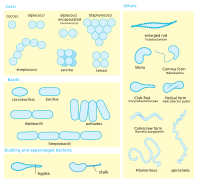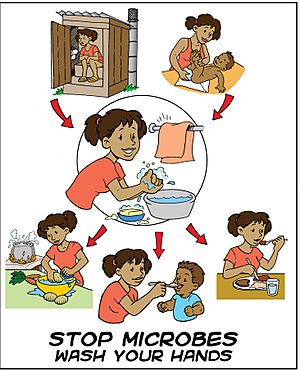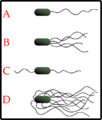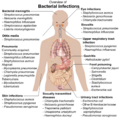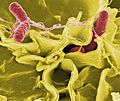Bacteria facts for kids
Quick facts for kids Bacteria |
|
|---|---|
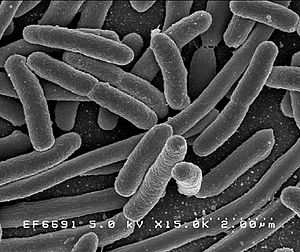 |
|
| Scanning electron micrograph of Escherichia coli rods | |
| Scientific classification |
|
| Domain: | Bacteria Woese, Kandler & Wheelis, 1990 |
Bacteria (sing. bacterium) are very small organisms. Almost all bacteria are so tiny they can only be seen through a microscope.
They are amongst the simplest and the oldest organisms and they function as independent organisms.
Bacteria are made up of one cell, so they are a kind of unicellular organism. They are among the simplest single-celled organisms on Earth, and were one of the earliest forms of life. They include a number of extremophiles which live in extreme habitats.
There are probably more individual bacteria than any other sort of organism on the planet.
Most bacteria live in the ground or in water, but many live inside or on the skin of other organisms, including humans.
There are about the same number of bacterial cells in the human body as human cells.
Some bacteria can cause diseases, but others help us in everyday activities like digesting food (gut flora).
Some even work for us in factories, producing cheese and yogurt.
The founder of bacteriology was a German biologist called Ferdinand Cohn (1828–1898). He published the first biological classification of bacteria, based on their appearance.
Contents
Shape
Bacteria vary widely in size and shape, but in general they are at least ten times larger than viruses. A typical bacterium is about 1 µm (one micrometer) in diameter, so a thousand bacteria lined up would be one millimeter long. There are about five nonillion (5×1030) bacteria on Earth.
Bacteria are identified and grouped by their shapes. Bacilli are rod-shaped, cocci are ball-shaped, spirilla are spiral-shaped, and vibrio are shaped like a comma or a boomerang.
Pathogens
Pathogenic bacteria, the harmful kind, enter the human body from the air, water or food. Once inside, these bacteria attach themselves to or invade specific cells in our respiratory system, digestive tract or in any open wound. There they begin to reproduce and spread while using your body's food and nutrients to give them energy to help them reproduce and they can make us sick.
An example of pathogens that cause food poisoning are Salmonella, Campylobacter, E. coli and Listeria. This happens when these bacteria get into the food we eat, perhaps if it's too old or hasn't been kept in the fridge.
Some pathogens can be avoided by washing your hands regularly with soap and water so any germs you might have picked up touching things can be washed off.
If you fall and scrape your knee, cleaning the wound with antiseptic helps stop pathogens entering your body.
Extremophiles
Some bacteria are extremophiles. These are bacteria that can live in very extreme conditions. For example some can live inside rocks up to 580 meters below the sea floor. According to one of the researchers, "You can find microbes everywhere — they're extremely adaptable to conditions, and survive wherever they are."
Interesting facts about bacteria
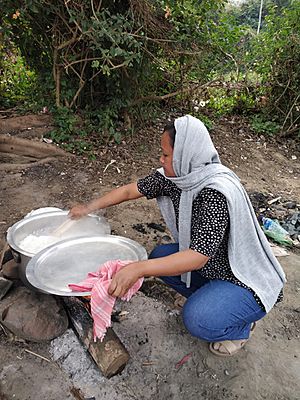
- There are four major types of germs – bacteria, viruses, fungi and protozoa.
- The majority of the bacteria found in the body live in the gut, but can be found pretty much anywhere in or on the human body.
- Always flush the toilet with the lid down as flushing the toilet with it up can cause a cloud of microscopic bacteria to become airborne from the toilet!
- Bacteria are all over household items like tv controllers, phones, cutting boards etc. Kitchen sponges can have up to forty-five billion microbes per square centimeter! It's a good idea to replace your kitchen sponges regularly.
- One of the reasons we cook food is to heat it to kill off pathogens.
- Some bacteria are needed in the environment to break down dead organisms.
- Scientists have found a bacteria that can eat plastic (pseudomonas bacteria). The bacteria eats polyurethane which is difficult to recycle and decomposes very slowly. This could be a big breakthrough in reducing the amount of plastic waste we have on the earth.
Related pages
Images for kids
-
Rod-shaped Bacillus subtilis
-
Phylogenetic tree of Bacteria, Archaea and Eucarya. The vertical line at bottom represents the last universal common ancestor.
-
An electron micrograph of Halothiobacillus neapolitanus cells with carboxysomes inside, with arrows highlighting visible carboxysomes. Scale bars indicate 100 nm.
-
Helicobacter pylori electron micrograph, showing multiple flagella on the cell surface
-
Bacillus anthracis (stained purple) growing in cerebrospinal fluid
-
A culture of Salmonella
-
A colony of Escherichia coli
-
Phylogenetic tree showing the diversity of bacteria, compared to other organisms. Here bacteria are represented by three main supergroups: the CPR ultramicrobacterias, Terrabacteria and Gracilicutes according to recent genomic analyzes (2019).
-
Antonie van Leeuwenhoek, the first microbiologist and the first person to observe bacteria using a microscope.
See also
 In Spanish: Bacteria para niños
In Spanish: Bacteria para niños


